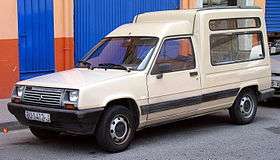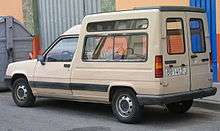Renault Express
| Express | |
|---|---|
 | |
| Overview | |
| Also called | Extra, Rapid |
| Production |
1985–2000 1996–2002 (South America) |
| Body and chassis | |
| Body style | Van |
| Dimensions | |
| Wheelbase | 2,580 mm (101.6 in) |
| Length | 4,056 mm (159.7 in) |
| Width | 1,566 mm (61.7 in) |
| Height | 1,776 mm (69.9 in) |
| Chronology | |
| Predecessor | Renault R4 F6 |
| Successor | Renault Kangoo |
The Renault Express is a panel van of the French automobile manufacturer Renault, which in July 1985 succeeded the R4 F6, and was placed on the market. It was based on the second generation Renault 5.
It was commercialised in some European countries as the Renault Extra (United Kingdom and Ireland),Renault Rapid (mainly German speaking countries) or Renault Express (in France, Spain, Austria, Switzerland, Italy, Japan, Taiwan). From 1996 to 2002, the Express was produced for South America at Nordex in Uruguay.
Structure
Technically, the Express was based on the second generation of the Renault 5 to which it is identical, except for a few stylistic changes, back to the A-pillar. It also uses the two front doors from the 5-door car.
Special features of the Express compared to the Renault 5 were the lengthened wheelbase by about 15cm, the raised roof over the driver's cab and the box structure behind the B-pillar. The vehicle came as a non or partially glazed panel van version with up to two seats, as a glazed combi with five seats. Rear access was double doors in the rear (with or without 'giraffe hatch' above for long items) , or with a large, upward opening tailgate. The Express was also supplied as pickup, as standard factory wheelchair vans or with various special bodies (refrigerated trucks, workshop vehicles available, etc.).
As with its predecessors, the Renault 4 F4 and F6, all wheels were individually suspended: The front by MacPherson struts and wishbones and the rear by trailing arms with torsion bars. Most similar vehicles, such as the Volkswagen Caddy or Opel Combo etc. had a rear dead axle with leaf springs. Ford bought in the Renault Express rear suspension for their 1990s Fiesta Courier.
Model series
The facelift was carried out, as in Renault usual, in several so called phases.
The first version (Phase 1) was built from the middle of 1985 until the summer 1991. Here, Renault first offered a panel van with a 1600cc diesel engine (40 kW/54 hp), while the gasoline engines came from the Renault 5 for use. Also discoverable were the almost vertical headlamps.
In the summer of 1991, a revision was carried out for Phase 2. The engine range changed, because now partially machines from Renault Clio were taken. Added to this was, among other things, a 1900cc diesel engine with 47 kW (64 hp). Also discoverable was at the modernised radiator grill, which was usually kept in gray plastic and aerodynamically slightly cheaper.
The Phase 3 of the model was from the beginning of 1994 until its replacement, the Kangoo, was launched in the end of 1997. The biggest differentiators were looking high quality materials, the radiator grille in body colour and the slightly revised taillights. At extra costs was for an airbag being available. Not only was the safety equipment upgraded, the comfort features, such as central locking with remote control, were updated as well.
In Phase 3, the 1600cc diesel engine was dropped. Production ended in July 2000.
Engine
| Model | Type | cylinder capacity cm³ | Max. power kW (hp) / rpm. | Torque Nm / rpm. | 0-100 km/t sec. | Year |
|---|---|---|---|---|---|---|
| Petrol | ||||||
| 1.0 | C1C | 956 | 31 (42) / 4400 | 63 / 2500 | 1986−1991 | |
| 1.1 | C1E | 1108 | 33 (45) / 4400 | 85 / 2000 | 20,1 | 1986−1991 |
| 1.2 | E5F | 1171 | 40 (55) / 6000 | 84 / 3500 | 16,5 | 1991−1997 |
| 1.2 | C3G | 1239 | 40 (54) / 5300 | 90 / 4800 | 16,5 | 1995−1997 |
| 1.4 | C2J | 1397 | 50 (68) / 5250 | 104 / 3500 | 14,5 | 1986−1992 |
| 1.4 | C3J | 1390 | 44 (60) / 5250 | 101 / 2750 | 1986−1992 | |
| 1.4 | E7J | 1390 | 55 (75) / 5600 | 109 / 4000 | 1991−1997 | |
| 1.5 | C3L | 1565 | 43 (58) / 5000 | 100 / 3500 | 14,5 | 1996−2000 |
| Diesel | ||||||
| 1.6 D | F8M | 1596 | 40 (55) / 4800 | 102 / 2250 | 17,8 | 1986−1991 |
| 1.9 D | F8Q | 1870 | 40 (55) / 3900 | 123 / 2250 | 18,5 | 1995−1997 |
| 1.9 D | F8Q | 1870 | 47 (64) / 4500 | 118 / 2250 | 16,5 | 1991−1997 |
- Phase I Front
 Express I Rear
Express I Rear Phase I Pickup in Taiwan by Sanfu Motor
Phase I Pickup in Taiwan by Sanfu Motor Phase II
Phase II Phase II III Rear
Phase II III Rear Phase III
Phase III Phase III
Phase III Phase III Rear
Phase III Rear- Phase III
| Wikimedia Commons has media related to Renault Express. |